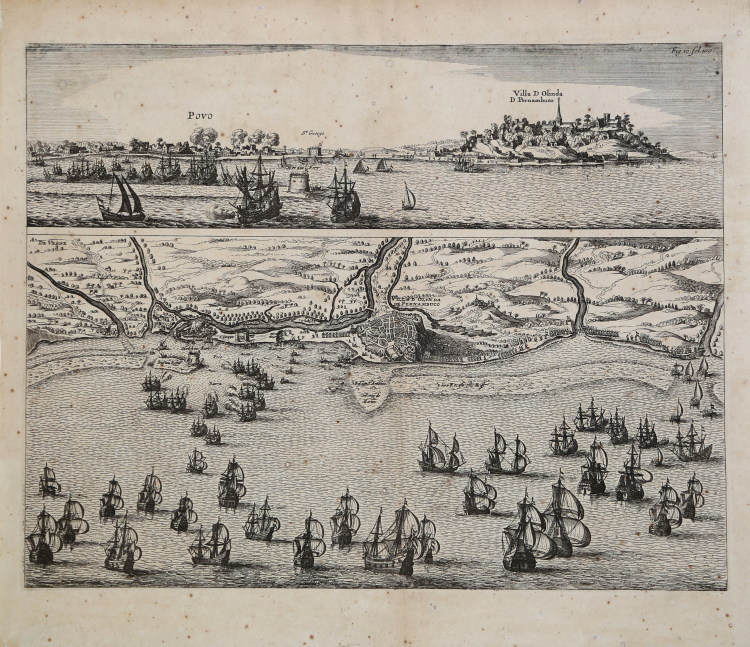



| Reference: | S34931 |
| Author | Isaac Commelin |
| Year: | 1652 |
| Zone: | Olinda |
| Printed: | Utrecht |
| Measures: | 338 x 267 mm |


| Reference: | S34931 |
| Author | Isaac Commelin |
| Year: | 1652 |
| Zone: | Olinda |
| Printed: | Utrecht |
| Measures: | 338 x 267 mm |
These splendid views illustrate the Dutch attack on the Portuguese city of Olinda in 1630.
Throughout most of the seventeenth century Portugal and Holland had a commercial agreement in which the Portuguese colonies in the New World produced sugar, and the Dutch distributed it across Europe using their vast commercial network. After the kingdoms of Portugal and Spain merged, the Dutch lost their distribution monopoly and created the West Indian Company in 1621.
Shortly thereafter the Dutch began its attack on Pernambuco, first at Salvador and then at Olinda. At top is a view of Povo and Olinda as seen from the sea. At bottom is a large bird's-eye view of the region, filled with ships.
The plate is part of the book by Isaac Commelin "Fredrick Hendrick Van Nassauw Prince Van Orangien Zyn Leven En Bedryf."
A very fine book describing the life and naval & military campaigns waged by Fredrick Hendrick Van Nassau, Prince of Orange, and illustrated with copper engravings depicting the various battles and sieges involved in the struggle to control the wealth of South America, and the war in the Netherlands against Spanish dominion.
On the death of his brother Maurice in 1625, Frederick Henry succeeded him in the stadtholderates of the five provinces of Holland, Zeeland, Utrecht, Overijssel and Guelders, and in the important posts of captain and admiral-general of the Union. Frederick Henry proved himself almost as good a general as his brother, and a far more capable statesman and politician. For twenty-two years he remained at the head of government in the United Provinces, and in his time the power of the stadtholderate reached its highest point. The 'Period of Frederick Henry,' as it is usually styled by Dutch writers, is generally accounted the golden age of the republic. It was marked by great military and naval triumphs, by world-wide maritime and commercial expansion, and by a wonderful outburst of activity in the domains of art and literature. The chief military exploits of Frederick Henry were the sieges and captures of Grol in 1627, 's-Hertogenbosch in 1629, of Maastricht in 1632, of Breda in 1637, of Sas van Gent in 1644, and of Hulst in 1645. During the greater part of his administration the alliance with France against Spain was the pivot of Frederick Henry's foreign policy. Also mentioned in this volume is the Dutch Admiral and folk hero Pieter Pietersen Hein (November 25, 1577- June 18, 1629). In 1623, he became vice-admiral of the new Dutch West India Company (WIC) and sailed to the West Indies the following year. In Brazil, he briefly captured the Portuguese settlement of Salvador, personally leading the assault on the sea fortress of that town. Then he attacked Luanda in Angola but failed to capture the city. In a subsequent raid in 1627 to retake Bahia, he failed but captured over thirty Portuguese ships with a large cargo of sugar. He also captured half of the Spanish treasure fleet in Matanzas Bay, Cuba and the resulting booty funded the Dutch army and allowed the subsequent capture of the town of S'Hertogenbosch.
Isaac Commelin
Isaac Commelin